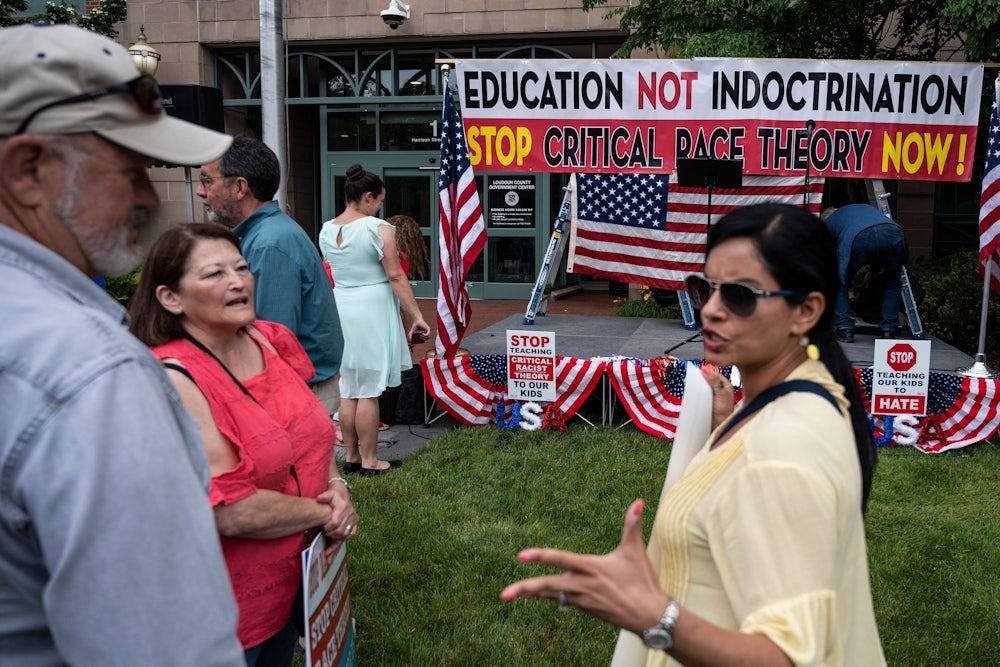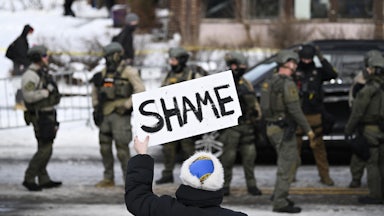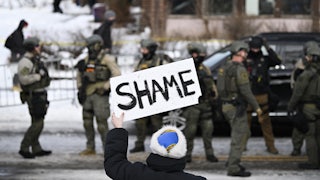Until last year, my pinko politics mostly found expression online. I did not expect that to change when I moved to the country, after retiring from the federal government. But lo and behold, an obligation to vault beyond cyber-engagement arose when a bitter racial struggle erupted in my new home in Loudoun County, Virginia, a good hour’s drive from downtown Washington, D.C. The ostensible object of controversy is critical race theory, but arguably, something else is going on.
A little background on the setting. Loudoun is one of the richest counties in the United States. Its suburbs range from modest to well-to-do. The biggest city is Leesburg, with a population of 54,000, so we are mostly suburban and rural, with McMansions, wineries, farms, and grand horsey estates. I can drive for 10 minutes from home and see cows, sheep, and horses, so I like to say I live in the country. The gas stations sell live bait, and the hardware stores sell ammo. One of my neighbors has his own firing range. Truth be told, I’m in one of those developments of $400K houses that all look pretty much the same.
I can also drive for 30 minutes and see server farms, known here as “data centers.” These are vast, low-slung, windowless buildings. Highly capital intensive, these facilities employ about 11,000 people in Northern Virginia, by Fairfax County’s estimate. The industry claims its average annual wage is $120,000. The centers are said to bring in a bounty of property tax revenue, though they also benefit from state government tax concessions. All the big tech giants are here. We also have the headquarters of AOL, though its glory days are so far behind us that it feels right to mention it last.
Loudoun is the fourth-largest county in Virginia by population. Joe Biden received 62 percent of the vote here. The county and the state have gotten bluer over the past 20 years. Virginia has above-average levels of income, education, and nonwhite population. No doubt the same is even truer for Loudoun. The foreign-born population tends to hail from South Asia and Central America. The Asians are disproportionately of working age and hold white-collar jobs. We could see Loudoun as typical of the gaps in the electoral armor of Republicans nationwide.
The blue here was renewed in 2017 with the election of Ralph Northam as governor and the arrival of an interesting new state legislature. In his primary, Northam had prevailed over Obama Democrat Tom Perriello and is on a moderate point of the spectrum (in the general election, Trump sabotaged the campaign of Bushist Republican Ed Gillespie).
But beyond the governor’s race, the changes the state has undergone manifested themselves in far more interesting ways. The state legislature saw the introduction of a transgender delegate, a full-fledged member of the Democratic Socialists of America (who led a chorus of “Solidarity Forever” at his victory party), its first Latina members, its first Asian-American member, and its first out-of-the-closet lesbian. You get the idea. As Divine would have said, the times they were a-changin’. The numbers of non-Hispanic, non-Asian white folks in Loudoun are declining, relatively speaking, and the good old boys are gripped by fear of a Black planet.
A panic over gun rights ensued when the Democrats took hold of the state government. Mass meetings were held in other rural counties, stoked by hysterical claims that the new state government would outlaw martial arts schools and such. By 2019, several dozen counties (out of more than a hundred) vowed to ignore “unconstitutional gun laws.” There were no such rallies in Loudoun. In the end, the actual changes in firearms regulation by the new government tend to be broadly supported, and gun law angst has failed to take root.
Critical race theory came to my attention in April 2020, with the news account of a tumultuous county school board meeting. There was a new undercurrent of protest over the school board’s efforts at promoting diversity, equity, and inclusion that was used to boost recall elections of board members. A similar initiative of lesser magnitude was launched in next-door Fairfax County. There is also a campaign to recall three of our newly elected county prosecutors, including Loudoun’s Buta Biberaj, for being “soft on crime” and getting financial support from George Soros.
The forty-fifth president blew the loudest dog whistle with his executive orders barring the use of CRT in the management of federal employees. As an economist, I’d little cause to delve into CRT, but after rummaging through my books, I found an anthology (known to aficionados as “the big red book”) that I had bought long ago, on the possibility I might want to read it someday.
It turns out that CRT is pretty damn interesting. It can be dense, since it’s law school lit. The idea might be summed up in the premise that race-neutral law can be conducive to racially biased social outcomes, or at least fail to preclude them. You can also find criticism of “integrationism” that informs an understanding of historic appeals for Black power. This is all grist for the mill of any radical, but not a likely text for Virginia high school students or fuel for sensitivity training in the federal civil service. Offended by the gross distortions of CRT by its erstwhile critics, which boil down to the canard that anti-racism is actually racist, I was inspired to publish letters in the local paper and was duly attacked online by equally obscure parties.
When anti-CRT activists are confronted with the irrelevance of CRT proper to any likely public school curriculum, they retreat to charges of a popularized CRT being inculcated. A commonly cited example is the very accessible, pointed writing of Professor Ibram X. Kendi, recently ensconced at American University in Washington, D.C.
Even so, their depictions of Kendi’s work are wildly off-base. For instance, it is claimed that Kendi and CRT posit a hierarchy of races, with whites at the bottom of the totem pole. There is no such thing in Kendi or CRT. Another slur is that to Kendi, all white people are racist. In fact, he asserts more than once that racism is common to all peoples, including himself. Kendi’s actual politics are wholesomely, tolerantly liberal, with a radical thought here and there. CRT and Kendi speak of systems and institutions, not of malevolent white people.
Another source for anti-CRT agitators is the plethora of materials used in public schools toward the promotion of supportive learning environments for minority and LGBTQ students and for teaching about racism. The wealth of texts and fugitive literature on U.S. race relations provides ample fuel for those who are not reluctant to employ cherry-picking and out-of-context references. The county superintendent told The Washington Post that anti-CRT protesters had photoshopped the school board logo onto CRT materials.
This is the fruit of a new cottage industry of anti-anti-racist entrepreneurs. The most prominent is one Christopher Rufo, a frequent guest on Fox TV from Seattle who can be credited with fomenting a national, online race riot. We also have local characters in Virginia trying to get in on the grift. Rufo has affirmed publicly that his strategy is to stigmatize any remotely anti-racist initiatives under the rubric of CRT. New reporting in The Nation points to a buildup of Koch network funding for such protests.
The leaders of this agitation have well-established, long-standing links to right-wing politics and the Trump administration. In the wake of the massive discrediting following the Capitol riots of January 6, my suspicion is that targeting local school boards on white-racial and culture-war grievances is a new Trumpist strategy for grassroots organizing.
Blue Virginia is a logical target. If its upscale suburbs can be turned around with race panic, the state’s hefty 13 Electoral College votes come into play. Replicate this nationally, and the Democrats’ prospects for 2024 and after look dim.
There will be a gubernatorial election this year. The former term-limited Democratic governor, Terry McAuliffe, is back in the fray, facing Republican Glenn Youngkin, who is focusing his campaign on the CRT flap. Dr. Ben Carson, Trump’s befuddled secretary of housing and urban development, has been recruited for backup.
Shortly after April 2020, the Loudoun school board was hit with the drop of a second shoe—a dispute over protocols for treatment of transgender students, including requirements for teachers to use students’ preferred pronouns and no requirements for parents to consent. Dick could demand, unbeknownst to her parents, that her teachers address her as Jane.
At first blush, this seemed to me a genius move by the bad guys. But it has not turned out to be so. In opposition to the entire mishigas of Trump-oriented activism, an upsurge of anti-racist, LGBTQ-friendly parents has announced itself. These are mostly women, with what might be called a vanguard of transgender students’ moms, and they are fierce. They are the sort of people—the “Resistance”—often credited with forming the nucleus of the Democrats’ suburban strength since 2016. One of their leaders is the bicycle rider who gave Trump the famous middle finger in 2019. She was later elected to the county Board of Supervisors. (Aside from flipping the bird, she actually brought a strong résumé to the position.)
The right’s error here is overlooking the fact that while the CRT animus and transgender bias sometimes play well, they don’t resonate much outside of Trump’s hard core. Well-off Loudoun is not going to be stirred up by gun rights or the old transgender bathroom stuff, which played out years ago. Loudoun students are prone to support their peers and lack the twentieth-century prejudices about gender. Immigrants and minorities will not be mobilized by those who have revealed themselves as hostile to their identities. A majority of Loudoun’s students are now black, Hispanic, or Asian.
Anti-CRT may have gone national, but it’s also running aground. Resolutions banning the teaching of CRT enacted in state legislatures lack force because CRT is not in fact being taught, and because state lawmakers are not well situated to micromanage how racism is discussed in a multitude of school systems, schools, and classrooms.
Public education’s decentralization defies that sort of dragooning. As a critic of liberal school boards and CRT noted in The Wall Street Journal, “Even where allowed to stand by courts, these laws, like other efforts to rein in education bureaucrats, will be swallowed up in the spreadsheets and matrices into which state departments of public instruction lure and quietly strangle every curricular reform.” It’s what we economists call the principal-agent problem.
In Loudoun, the main Trumpists’ tactic was to ventilate their grievances at school board meetings. In one especially rowdy episode on June 22, the board meeting had to be adjourned. Clearing the room led to a melee between Trumpist protesters and the county sheriff’s deputies. At the next meeting, the school board arranged tight security. There was no repeat of the disruption that broke up the previous meeting. It turns out that decorum is the antidote to Trumpist agitation. A gentleman arrested in the previous fracas has now been convicted of disorderly conduct.
The board subsequently passed new regulations in support of transgender students and ignored the complaints of Christian fundamentalist teachers who protested that their religious freedom was being infringed upon by the requirement to refer to students as “they” rather than he or she. One such teacher was suspended. Another resigned publicly at the August 10 board meeting and was met with deaf ears.
A civil suit was brought against one school by anti-CRT fanatics charging that the school’s diversity-oriented club was excluding white students. This suit has been struck down. A court case to further a recall effort in neighboring Fairfax was also struck down.
In general, if you are reduced to recall elections, and the authorities maintain order at public functions, your political agitation devolves to low energy. After all, a recall means you’ve already lost once. You’re also telling a majority of the electorate that they voted wrong. A recent poll puts McAuliffe ahead of Youngkin by nine points.
Loudoun County led the state in population growth in the 2020 census, with a whopping increase of 35 percent. The growth is disproportionately well-off, tech-oriented, and foreign-born. It’s doing wonders for my house’s resale value. Demography may not be destiny, but for the moment it is a specter that must haunt the hopes of the Republican Party of Virginia.








